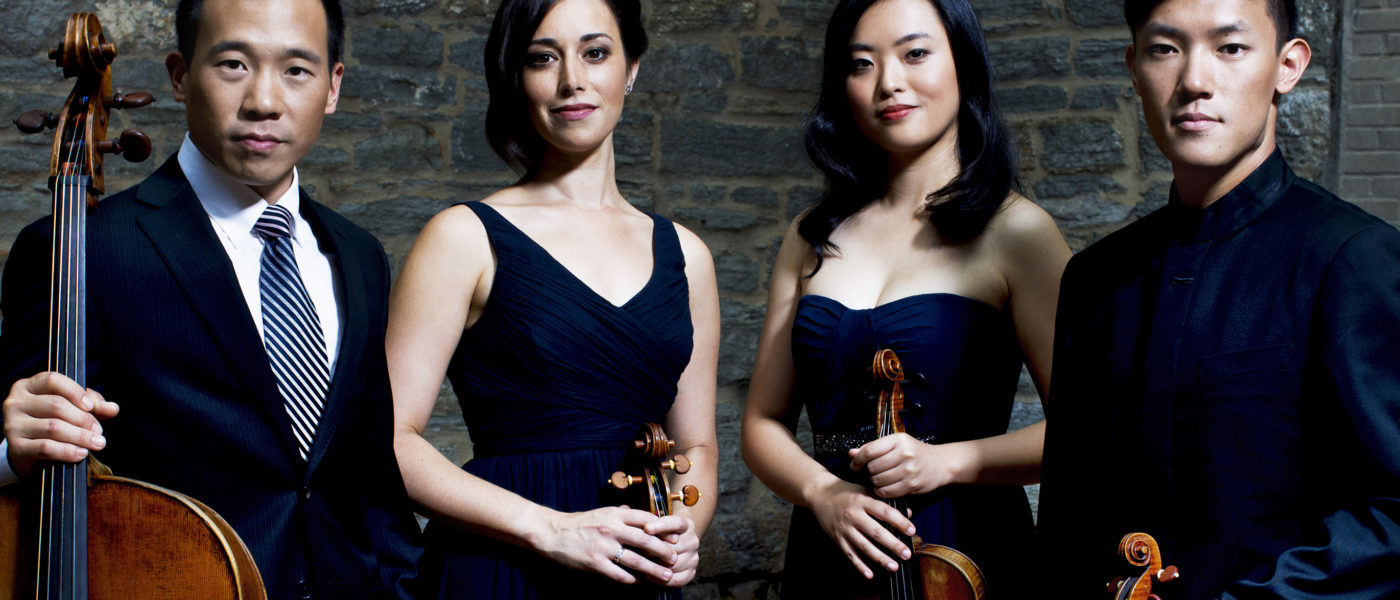The Sheen Center for Thought and Culture Classical Music Series curated by Mark Kaplan presents the Parker Quartet in Review
Parker Quartet
Daniel Chong, violin; Ying Xue, violin; Jessica Bodner, viola; Kee-Hyun Kim, cello
Featuring special guest Charles Neidich, clarinet
Loreto Theater, New York, NY
Thursday, January 12, 2017
The Parker Quartet needs no advocacy from me—they are Grammy winners, artists-in-residence at both Harvard and USC, and regularly tour, record, and perform with the world’s finest collaborators. Their program was beautifully conceived: two major works, each by a classical/romanticist (or a romantic/classicist, if you prefer)—Mendelssohn’s first essay in the string quartet, and Brahms’ sentiment-drenched, nearly-final chamber work. Both works are also cyclical (music from the first movement recurs at or near the end of the final movement). The concert was without intermission, a form which appeals to me (and apparently to audiences).
Due to a colossal GPS/GoogleMaps failure, this reviewer was late to the hall, and had to witness the Mendelssohn from the lobby on a TV screen with sub-par volume. Therefore, the comments in most detail will be directed at the Brahms.
Mendelssohn’s opening gesture from the E -flat tonic triad up to D-flat seems to embody a world of yearning “just out of reach,” and is indebted to Beethoven’s Op. 74 as well. The Canzonetta in G minor (with faster scherzando middle section) may have inspired his colleague Robert Schumann in the final movement of Kreisleriana. The Andante espressivo in B-flat major leads without pause into the finale, which spends most of its time in C minor, until the cyclic coda resolves to E-flat major. In 1830, Mendelssohn added a secret dedication on the manuscript of Op. 12 to “B.P.” (Betty Pistor, 1808-1887), a member of the Singakademie conducted by Zelter, for which Felix was accompanist. He had a teen crush on her. B-flat up to E- flat- “Bes,” three musical letters of her name, forms a prominent thematic element. After he learned of her engagement to Rudorff, he had his friend Ferdinand David change the P to an R.
From what I was able to see (primarily) in the lobby, the quartet’s visual synchronization was a marvel, and their energy infectious. Of course, their intonation and phrasing were impeccable. Their choices were those of youth and impetuosity, certainly valid in the case of Mendelssohn, his infatuation, and their own youth. There may be, however, other nuances, less vehement, more in the direction of elegance and even restraint, that they will discover as they mature. Nevertheless, to play at this level is a marvel.
Brahms described his Quintet for clarinet and string quartet as “a far greater folly” (than the clarinet/cello/piano trio). It was conceived for Richard Mühlfeld (1856-1907), originally a violinist and self-taught clarinetist (!), who played in the Meiningen and Bayreuth orchestras, and whom the normally gruff Brahms called “Fräulein Klarinette,” “my dear nightingale,” “my Primadonna,” and “Fräulein von Mühlfeld.” Tonight, the legendary Charles Neidich expressed the clarinet part from the most lyrical place imaginable—his lifetime of living with the single-line instrument leaving no inflection unexplored, no color unpainted, our dear nightingale indeed. It was a master class for all musicians, really. Here, I felt the Parkers could have provided a deeper, darker velvet carpet for the clarinet to “walk” on. Though the ensemble was perfect, particularly the way the violist leaned physically toward her clarinet neighbor, the strings’ inflections were “paler” than the clarinet, sometimes giving the impression of a background rather than a full chamber texture. (I realize I am nit-picking!) They understood and reflected every harmony and texture, however. The Adagio had a beautiful meditative, rapt quality. The balance issue was overcome beautifully in the third movement, which suddenly sprang to full life and energy, and mostly in the fourth movement, where the final return of the first movement’s sadness was rendered in appropriately awestruck hushed tones.

